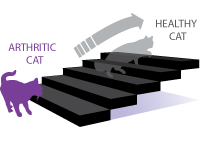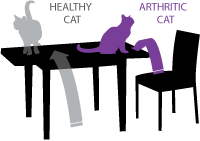what to do for a cat with arthritis
Arthritis
in cats

4 signs
Using a chair to get to the favourite spot
Arthritic cats might use a chair to help them leap onto a table, bed, chair...
Nearly
arthritis
What is feline arthritis?

Healthy cartilage
& os
Mild cartilage
harm
Astringent arthritis
with cartilage and bone
changes
Signs
of arthritis

Changes in hygiene
- Reduced time spent training
- Disordered and scruffy coat
- Inappropriate urination or not using the litter

Changes in mood
- Irritable when handled
- Increased aggression or bitter
- Avoiding contact with people or other animals

Reduced action
- Increased time sleeping
- Hesitant to play
- Unwilling to become out or explore

Reduced mobility
- Hesitant to leap up or down
- Making smaller jumps
- Difficulty climbing the stairs, getting into the litter or using the cat flap
- Stiffness
Some subtle behaviour changes yous may observe in your cat
 Arthritic cats may be hesitant to jump off a table
Arthritic cats may be hesitant to jump off a table
 Arthritic cats might be hesitant to climb stairs
Arthritic cats might be hesitant to climb stairs
 Arthritic cats play lessfrequently and spendmore fourth dimension sleeping
Arthritic cats play lessfrequently and spendmore fourth dimension sleeping
 Arthritic cats might use a chair to help them leap onto a tabular array
Arthritic cats might use a chair to help them leap onto a tabular array
Diagnosis
& direction
Often the first step in diagnosing arthritis is recognising the signs at abode. If you see any of the subtle signs, it'south a good idea to take your cat examined past your vet. They may be able to find swelling, hurting and inflammation or accept a radiograph to confirm any suspicions.
The skilful news for cats and their owners is that arthritis can exist managed successfully with appropriate treatment and simple changes to your true cat's environment.
Medication for arthritis tin can assist reduce pain and inflammation to improve your cat's quality of life, though it will not cure arthritis. In many cases, animals afflicted by arthritis volition need to be on medication for the rest of their lives.
The most commonly used drugs for managing arthritic hurting are chosen non-steroidal anti-inflammatory drugs (NSAIDs). These drugs tin be very effective at decision-making the hurting and inflammation associated with arthritis, merely pet owners must take proper care when administering them and they should always be used under direct veterinary supervision to avoid the run a risk of side effects.
Usually, a combination of medication and complementary approaches, including diet and weight management and physiotherapy is used to treat arthritis.
Every true cat requires a specific handling programme. Your veterinarian volition exist in the best position to discuss a tailored treatment program for your cat.

Special supplements & Diets
Omega-three fat acids
Chondro protectant
Illness Modifying Agents,
Nutraceuticals
Weight control & exercise
Weight reduction, nutrition management
Physical rehabilitation
Physiotherapy, gentle exercise, massage,
Hydrotherapy, Heat and common cold therapy
Pharmaceuticals
Non-steroidal anti-inflammatory drugs,
the cornerstone of arthritic pain management

Tips to help look after your cat
- Have regular cheque ups; as cats age information technology'southward important to maintain advice with your vet to ensure they're enjoying their senior years.
- Encourage play and interaction to provide exercise and mental stimulation.
- Cut their claws or provide a scratching mail
- Spend some time cleaning and grooming your cat.
- Provide a litter tray with a depression side for easier access. Keep information technology in asecluded place where they experience safe; avoid busy areas of the house andposition away from the cat flap.
- Brand sure nutrient and water is easy to access and go along a 2d basin of water in a dissever place.
- Have steps or ramps for access to higher spots
- Provide a soft comfortable bed in a quiet location.
 Print
Print
Think to always follow the advice of your vet.
Instance
Study
See the difference treatment tin make
Helping you manage
feline osteoarthritis in practice
Source: https://catswitharthritis.com/
0 Response to "what to do for a cat with arthritis"
Post a Comment